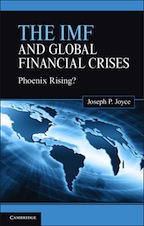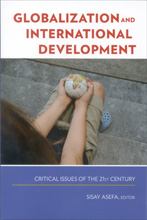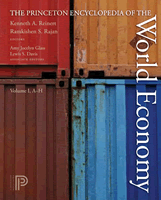Journal Articles
"The Sources of International Investment Income in Emerging Market Economies,'" Review of International Economics, vol. 29 (2021), p. 606-625.
We investigate international investment income flows in 26 emerging market countries during the period of 1998-2015. Net investment income registered a deficit for this group of countries of between 2-3% of GDP during this period. This deficit has been dominated by payments on foreign direct investment liabilities, which is consistent with the change in the composition of the external liabilities of these countries. Our results indicate that both capital account and trade openness are associated with the deficits on direct investment income. In addition, there was a small deficit in portfolio investment income, which is affected by the development of domestic financial markets and investor protection. Other investments’ income and the income from foreign exchange reserves have a negligible role in total investment income.
This paper investigates the change in the composition of the liabilities of emerging market countries from primarily debt (bonds, bank loans) to equity (foreign direct investment, portfolio) in the decades preceding the global financial crisis. We examine the determinants of equity and debt liabilities on external balance sheets in a sample of 21 emerging market economies and 20 advanced economies over the period of 1981-2013. We include a new measure of domestic financial development that allows us to distinguish between financial institutions and financial markets. Our results show that countries with higher economic growth rates have larger amounts of equity liabilities. The development of domestic financial markets is also linked to an increase in equity liabilities, and in particular, portfolio equity. In addition, larger foreign exchange reserves are associated with larger amounts of portfolio equity. FDI liabilities are more common when domestic financial institutions are not well developed.
The external balance sheets of many emerging market countries are distinguished by their holdings of assets primarily in the form of foreign debt and foreign exchange reserves, while their liabilities are predominantly equity, either FDI or portfolio. In this paper we investigate the claim that this composition served as a buffer for the emerging markets during the global financial crisis of 2008-09. We use data from a sample of 67 emerging market and advanced economies, and several indicators of the crisis are utilized: GDP growth rates in 2008-09, the occurrence of bank crises and the use of IMF credit. Our results show that those countries that issued FDI liabilities had higher growth rates, fewer bank crises and were less likely to borrow from the IMF. Countries with debt liabilities, on the other hand, had more bank crises and were more likely to use IMF credit. We conclude that the “long debt, short equity” strategy of emerging markets did mitigate the effects of the global financial crisis.
"External Liabilities, Domestic Institutions and Banking Crises in Developing Economies" (with Nabila Boukef Jlassi and Helmi Hamdi), Review of International Economics, vol. 26 no. 1 (2018), p. 96-116
We investigate the impact of foreign equity and debt on the occurrence of banking crises in 61 lower-income and middle-income economies during the 1984-2010 period. We also focus on the effects of domestic institutions on banking crises and whether they mitigate or exacerbate the impact of the external liabilities. We find that FDI liabilities lower the probability of a crisis, while debt liabilities increase their incidence. However, institutions that lower financial or political risk partially offset the impact of debt liabilities, as does government stability. A decrease in investment risk directly reduces the incidence of banking crises.
“Stock Markets and the Costs of Banking Crises” (with Tess DeLean), Journal of Financial Economic Policy, vol. 6 no. 4 (2014), p. 342-361
This paper aims to investigate whether stock markets can reduce the output costs of banking crises. The work is motivated by Alan Greenspan’s claim that capital markets serve as a financial “spare tire” in the event of a banking crisis. We test the impact of stock market capitalization, liquidity and turnover on the output losses of 76 banking crises in 66 countries over the period of 1975-2008. Our results indicate that stock markets can mitigate the effect of banking crises on economic activity. There is also some evidence that foreign equity holdings lower output costs.
These results suggest that the development of equity markets will contribute to reducing the costs of banking crises. Such development, however, should be accompanied by adequate supervisory and regulatory oversight.
"Financial Globalization and Banking Crises in Emerging Markets", Open Economies Review, vol. 22 no. 5 (2011), p. 875-895.
Bank crises in emerging economies have been a feature of the recent global crisis, and their incidence has increased in the post-Bretton Woods era. This paper investigates the impact of financial globalization on the incidence of systemic bank crises in 20 emerging markets over the years 1976-2002 using measures of de facto and de jure financial openness. An increase in foreign debt liabilities contributes to an increase in the incidence of crises, but foreign direct investment and portfolio equity liabilities have the opposite effect. A more liberal de jure capital regime lowers the incidence of banking crises, while a regime of fixed exchange rates increases their frequency. The results of the econometric analysis is consistent with the experience of European and central Asian emerging markets, which attracted a relatively large proportion of capital inflows in the form of debt in recent years and have been particularly hard hit by the global financial crisis.
"Reserves, Quotas and the Demand for International Liquidity" (with Raul Razo-Garcia), Review of International Organizations, vol. 6 no. 3-4 (2011), p. 393-413.
The foreign exchange reserves held by emerging market economies rose significantly in the last decade. This increase has been attributed to a desire by these countries to self-insure themselves against financial shocks. The rise in reserves may also reflect their concerns about the size of their IMF quotas, which set limits on the amount of credit that countries could draw from the IMF, and the conditionality associated with borrowing from the IMF. We offer a model of the choice by central banks between quotas and reserves to demonstrate that emerging markets will choose to hold relatively more reserves than advanced economies. We then investigate the impact of IMF quotas on reserve holdings for a panel of countries during the period of 1980-2006. In addition to finding evidence of precautionary and mercantilist motives for holding reserves in emerging markets, we also find that reserves in these countries have been inversely related to their IMF quotas.
“Sudden Stops, Banking Crises and Investment Collapses in Emerging Markets” (with Malhar Nabar), Journal of Development Economics, vol. 90 no. 2 (2009), p. 314-322.
This paper examines the effects of external and domestic financial crises on investment in a sample of emerging markets during the period 1976-2002. Our objective is to distinguish between the impact of capital reversals ("sudden stops") and domestic banking crises on investment. We find that in the absence of bank crises sudden stops do not have a significant effect on investment. Bank crises, on the other hand, have a significant negative effect on investment even in the absence of a contemporaneous sudden stop crisis. We also confirm that openness to capital flows exacerbates the severity of the adverse impact of banking crises on investment. The critical component of capital flight appears to be the reversal of short duration flows, intermediated through the banking sector. Our results provide statistical support for the policy view that a strong banking sector which can withstand the negative fallout of capital flight is essential for countries that open their economies to international financial flows.
"A True Test: Do IMF Programs Hurt the Poor?" (with Zlata Hajro), Applied Economics, vol. 41 no. 3 (2009), p. 295-306.
This article analyses the effect of IMF programs on poverty with data from 82 countries during 1985-2000. Two indicators of poverty, infant mortality rates and the human development index (HDI), are utilized, and the effects of the IMF's concessionary and nonconcessionary programs are investigated, as well as economic and institutional factors. The results show that the IMF's programs have no significant direct impact on poverty. Growth and good institutions, however, both have significant impacts, lowering infant mortality and increasing the HDI. The Fund's concessionary programs increase the impact of growth on lowering infant mortality, while the nonconcessionary programs lower the impact of growth on the HDI.
"IMF Retrospective and Prospective: A Public Goods Viewpoint" (with Todd Sandler), Review of International Organizations, vol. 3 no. 3 (2008), p. 221-238.
This paper investigates changes in IMF activities using the analytical framework of international public goods. Since its founding, the mix of IMF activities has changed greatly. IMF now promotes international financial stability, whose outputs are joint products with varying degrees of publicness. In recent years, IMF loans (recipient-specific benefits) have assumed decreased importance, while the Fund's technical assistance and monitoring activities have taken on greater importance. As a consequence, the club and purely public outputs (e.g., disseminating best practices) have grown as a share of IMF activities. The future of IMF is also addressed, especially in light of increased private capital flows.
“The IMF and the Liberalization of Capital Controls” (with Ilan Noy), Review of International Economics, vol. 16 no. 3 (2008), p. 413-430.
The International Monetary Fund has been blamed for precipitating financial crises during the 1990s by pressuring countries to liberalize their capital accounts prematurely. In this paper, we empirically evaluate this claim. Using data from a panel of developing economies from the 1982-98 period, we examine whether the changes in the regime governing capital flows took place during participation in IMF programs. We find evidence that IMF program participation is correlated with capital account liberalization episodes during the 1990s. We use the Miniane (2004) and Chinn-Ito (2005) indicators of capital account openness to test the robustness of our results. To determine whether decontrol was premature we compare the economic characteristics of countries that decontrolled during IMF programs with those of countries who did so independently. The former group of countries had larger current account and budget deficits, higher rates of inflation and lower reserve holdings before they liberalized than did the independent group. However, the group that deregulated capital flows while part of IMF programs recorded improvements in all these areas once liberalization was underway, whereas the second group only showed a fall in inflation.
“Promises Made, Promises Broken: A Model of IMF Program Implementation”, Economics & Politics, vol. 18 no. 3 (2006), p. 339-365.
A country that enters an IMF sponsored lending program agrees to enact stabilization and reform measures. The actual disbursal of funds by the Fund is tied through a process known as conditionality to the implementation of these policies. Many programs are not fully completed because the borrowing government fails to comply with the original agreement. This paper presents a model of program implementation, which is then empirically tested with data from the period 1975-99. The IMF and the borrowing country are shown to have asymmetric evaluations of a program’s discounted benefits, due to differences in their measurements of the benefits, the relevant time frame and appropriate discount rate. The model also distinguishes between a government that seeks to maximize national welfare and an autocracy that acts only to benefit the ruling group. It can also be shown that the existence of threshold effects in the benefits may result in dual optimal implementation rates. The results of the empirical analysis demonstrate that successful program implementation is affected by a country’s trade openness, the duration of the political regime, the ideological cohesion of the government, and the degree of political openness.
“Time Present and Time Past: A Duration Analysis of IMF Program Spells", Review of International Economics, vol. 13 no. 2 (2005), p. 283-297.
The programs of the International Monetary Fund were originally designed to provide short-term assistance to countries implementing policies to address balance of payments disequilibria. In recent decades, however, the Fund has instituted new facilities with longer time horizons, while many developing countries have adopted consecutive programs. As a result, the length of time spent by countries in IMF programs has grown. This paper analyzes the IMF program spells for a group of emerging economies over the period of 1982 to 2000. Duration models are used to investigate the time dependence of the failure rate of the spells and the factors that affect the duration of program spells. The hazard ratio of program spells has a non-monotonic shape, first rising and then falling over time. A spell’s duration is independent of a previous spell length or the number of previous spells. Program duration is extended for those countries with lower per-capita income, exports concentrated in primary goods, landlocked geographic status and autocratic regimes. Governments that are ideologically divided have shorter spells, which may reflect a breakdown in governance.
“Adoption, Implementation and Impact of IMF Programmes: A Review of the Issues and Evidence", Comparative Economic Studies, vol. 46 no. 3 (2004), p. 451-467.
This paper evaluates the literature on the lending programs of the IMF. The first section deals with the initiation of a Fund program, which has been shown to be influenced by political and institutional variables. A second focus of research analyzes the design and implementation of Fund supported polices, since many programs are often not successfully completed. The third issue surveyed is the impact of IMF policies on the economy of the borrowing government. The effect of Fund programs on private capital flows is also examined. The last section presents issues that merit further research.
"Many Happy Returns? Recidivism and the IMF" (with Graham Bird and Mumtaz Hussain), Journal of International Money and Finance, vol. 23 no. 2 (2004), p. 231-251.
IMF programs are designed to provide a temporary source of finance for countries with balance of payments disequilibria. Consequently, borrowing from the IMF should occur infrequently and be widely distributed among member countries. However, some countries are recurrent users of Fund resources. This paper investigates which variables account for multiple borrowings from the IMF. We use models of count data to examine the impact of the need for financing, domestic policies, external shocks, and structural and institutional factors on borrowings between 1980 and 1996. We find that recidivist borrowers have lower reserve holdings, larger current account deficits and capital outflows, lower but less volatile terms of trade, larger debt service and external debt ratios, lower investment rates and per-capita income, and weak governance.
Working Papers
Income generated by foreign direct investments (FDI) has grown since the 1990s, and now represents a substantial portion of many countries’ current accounts. However, some of these flows are received by Special Purpose Entities (SPEs) in financial centers that serve as conduits, and thus overstate the actual amount of income. We use IMF and OECD data to ascertain which countries receive FDI-generated income, and find that a few advanced economies are the recipients of the largest shares. We also investigate the factors that determine the amount of direct investment income that a country received during the period of 1990-2016, distinguishing between equity income and the interest income that arises from intra-firm borrowing. Larger capital stocks lead to more equity income, as does a record of patent applications. There is also evidence that the major recipients export less goods and services and import more. These characteristics are consistent with the formation of global supply chains that allow multinational firms to use information and communications technology to locate production abroad and coordinate the activities of foreign subsidiaries and their suppliers. Financial development is inversely linked to more debt payments. Most of the advanced countries in our sample recorded deficits on their debt income, consistent with a practice of borrowing from subsidiaries in order to lower their tax liability in the home country.
 Book
Book

 "Globalization and Inequality Among Nations", in Sisay Asefa (ed.),
"Globalization and Inequality Among Nations", in Sisay Asefa (ed.), 
 "Washington Consensus",
"Washington Consensus",